英语口语评分标准-中英版
英语口语口语考试评分标准

英语口语口语考试评分标准
英语口语考试评分标准是为了评估学生的英语口语能力,在口语交流中包括词汇使用、语法准确性、流利度、语音语调和交际能力等方面的表现。
评分标准的主要目的是确保考生在现实生活中能够有效地进行英语口语交流。
口语考试一般会分为不同的任务,如自我介绍、简单问答、描述图片、情景会话等。
以下是一些常见的评分标准:
1. 词汇使用:评估考生词汇的丰富程度和正确运用的能力。
考生应尽量使用准确、多样化的词汇来表达自己的意思。
2. 语法准确性:评估考生的语法运用能力。
考生应尽量避免语法错误,并能正确运用各种时态、语态等语法结构。
3. 流利度:评估考生口语表达的流畅程度。
考生应尽量避免卡壳、说话思路不清晰等问题,流利而自然地表达自己的意思。
4. 语音语调:评估考生的发音准确性、语调抑扬顿挫等方面。
考生应尽量准确地发音,注意语音语调的变化,并能够自如地使用连读、重音、停顿等语音特点。
5. 交际能力:评估考生与他人进行交流的能力。
考生应能够适应不同的语境,根据对话内容进行合理的回答和提问,并能够表达自己的观点和意见。
除了以上常见的评分标准外,口语考试还可能会根据具体任务设定相应的评分要求。
比如在描述图片的任务中,评分标准可能会包括描述图片内容的准确性、使用适当的描述词汇和语法结构等方面。
最后,评分标准并非固定不变的,不同的考试机构、考试形式和考试目的可能会有所不同。
因此,考生在备考口语考试时应熟悉具体考试要求,多进行口语训练,以提升口语表达的能力。
雅思口语评分标准(公众版)中英文对照版

inappropriate choices
markers with some flexibility
uses paraphrase effectively
6
is willing to speak at length, though may lose
uses vocabulary with full flexibility and
uses a full range of structures naturally and
uses a full range of pronunciation features
correction; any hesitation is content-related
shows some effective use of features but
uses a range of connectives and discourse
generally paraphrases successfully
structures, though these rarely cause
precision in all topics
appropriately
with precision and subtlety
rather than to find words or grammar
uses idiomatic language naturally and
produces consistently accurate structures
has insufficient vocabulary for less familiar
英语口语比赛打分规则
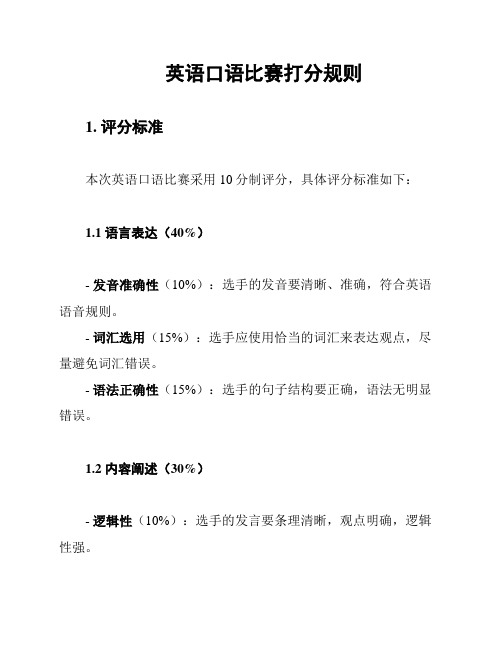
英语口语比赛打分规则1. 评分标准本次英语口语比赛采用10分制评分,具体评分标准如下:1.1 语言表达(40%)- 发音准确性(10%):选手的发音要清晰、准确,符合英语语音规则。
- 词汇选用(15%):选手应使用恰当的词汇来表达观点,尽量避免词汇错误。
- 语法正确性(15%):选手的句子结构要正确,语法无明显错误。
1.2 内容阐述(30%)- 逻辑性(10%):选手的发言要条理清晰,观点明确,逻辑性强。
- 丰富性(10%):选手应使用多样化的表达方式和丰富的词汇。
- 创意性(10%):选手在话题阐述中能展示出独特的见解和创意。
1.3 互动交流(20%)- 应答速度(5%):选手在回答问题时反应要迅速。
- 互动质量(10%):选手在互动中能否有效地回应对方,展示良好的沟通技巧。
- 团队协作(5%):在小组讨论环节,选手需要表现出良好的团队合作能力。
1.4 舞台表现(10%)- 自信度(5%):选手在舞台上的表现要自信,动作和表情自然。
- 舞台礼仪(5%):选手需要遵守舞台礼仪,如按时完成发言,不打断他人发言等。
2. 评分细节2.1 语言表达- 对于发音准确性,评委将注意选手的音素、语调、语速等方面的表现。
- 在词汇选用方面,评委将关注选手是否能够正确使用同义词、反义词以及专业术语等。
- 语法正确性方面,评委将着重看选手的时态、语态、句型结构等是否正确。
2.2 内容阐述- 逻辑性评判将基于选手发言的条理清晰度,论点论据的合理性。
- 在丰富性方面,评委将考察选手是否能够使用不同的句型和丰富的词汇表达。
- 创意性评判将基于选手对话题的独特见解和新颖表达。
2.3 互动交流- 应答速度关注的是选手回答问题的敏捷性,以及在思考时间内对问题的快速反应。
- 互动质量将根据选手回应问题的深度、广度以及能否有效推进对话来进行评判。
- 团队协作评判标准包括在小组讨论中是否能够倾听他人意见,以及能否在团队中发挥积极作用。
中译英 评分标准
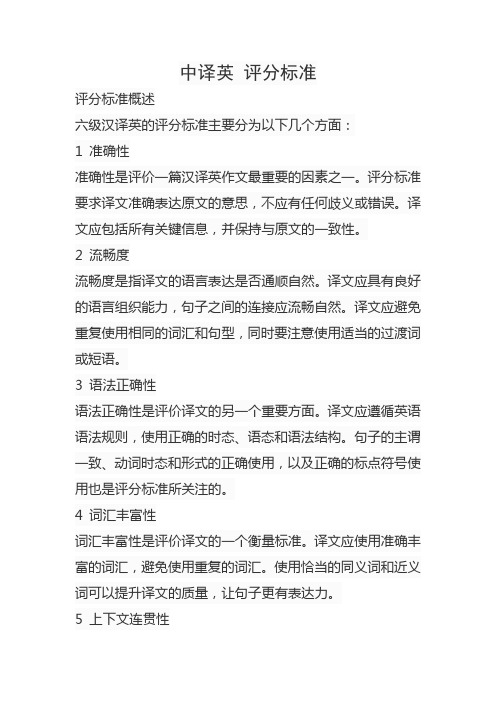
中译英评分标准
评分标准概述
六级汉译英的评分标准主要分为以下几个方面:
1 准确性
准确性是评价一篇汉译英作文最重要的因素之一。
评分标准要求译文准确表达原文的意思,不应有任何歧义或错误。
译文应包括所有关键信息,并保持与原文的一致性。
2 流畅度
流畅度是指译文的语言表达是否通顺自然。
译文应具有良好的语言组织能力,句子之间的连接应流畅自然。
译文应避免重复使用相同的词汇和句型,同时要注意使用适当的过渡词或短语。
3 语法正确性
语法正确性是评价译文的另一个重要方面。
译文应遵循英语语法规则,使用正确的时态、语态和语法结构。
句子的主谓一致、动词时态和形式的正确使用,以及正确的标点符号使用也是评分标准所关注的。
4 词汇丰富性
词汇丰富性是评价译文的一个衡量标准。
译文应使用准确丰富的词汇,避免使用重复的词汇。
使用恰当的同义词和近义词可以提升译文的质量,让句子更有表达力。
5 上下文连贯性
上下文连贯性是评价译文的另一个重要因素。
译文应能够准确地传达原文的内容,并保持上下文的连贯性。
译文中的句子应相互关联,内容之间应具有良好的逻辑性。
英语中级口译考试评分标准

英语中级口译考试评分标准英语中级口译考试评分标准听力部分:1. 听力Spot Dictation20个空,每个1.5分,只有名、动、形、副词直接扣分,扣分比重视该次考试的标准及该单词在词组中的重要程度而定,比如,a vital element如果vital没写,扣0.5分,element同理,如果a不写,不直接扣,教师在卷面做标注,比如红点,然后20个格子阅完后视标注情况整体再扣1-3分。
不是很严重的拼写错误不扣分,比如resistant写成resident.允许适当连笔书写,只要不影响老师的评改。
2. 听力选择共30题,每题1分,共计30分。
3. 听译Sentence & Passage translation句子翻译每句3分,也是整体评分,比如通读译文,大致给出是0,1,2,3档,这个标准与第二试的口译一致,要求给出大意,及主要的细节;要求逐字对应,不得出现严重误译,反译。
举个简单例子,原文是Britain witnessed sharp increase in its criminal activities from l999 to 2003。
如果译文是1999-2003年间英国犯罪率上升了。
那么基本是满分3分,不强求要把sharp体现出来,而witness目睹了这个意思也不用很精确。
如果写成1999-2002,扣0.5,如果没写出犯罪率或者犯罪案件这个概念,得分不超过1分,因为意思都不对了。
如果把increase译成了犯罪率下降,起码扣1分。
段落翻译两篇,一般是7+8分,passage的'概念可以按照2-3句句子来理解,评分标准同理。
高口这个部分阅卷相对宽松,允许出现部分细节的遗漏。
比如原文是in the areas Of economy,finance,trade,shipping,insurance,realestate,六个关键词一般译出五个就肯定是满分,如果那次考试普遍得分较低,四个也可以不扣分。
IELTS口语评分标准(中英文)
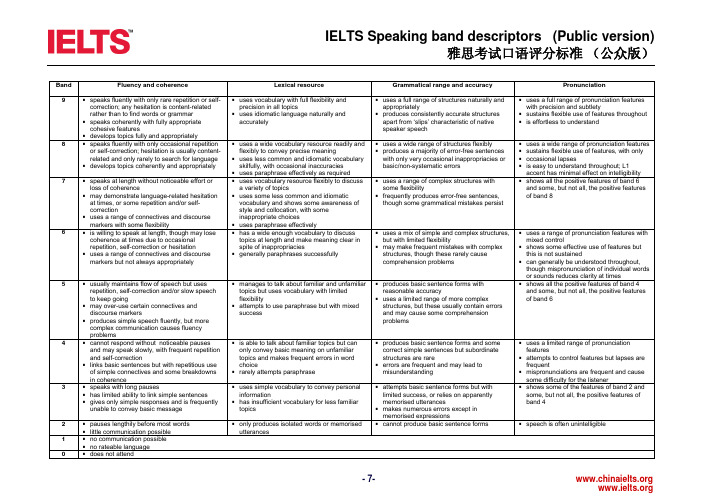
- 7-Band Fluency and coherenceLexical resourceGrammatical range and accuracy Pronunciation9speaks fluently with only rare repetition or self-correction; any hesitation is content-related rather than to find words or grammarspeaks coherently with fully appropriate cohesive featuresdevelops topics fully and appropriatelyuses vocabulary with full flexibility and precision in all topicsuses idiomatic language naturally and accurately uses a full range of structures naturally andappropriatelyproduces consistently accurate structures apart from ‘slips’ characteristic of native speaker speech uses a full range of pronunciation features with precision and subtletysustains flexible use of features throughout is effortless to understand8speaks fluently with only occasional repetition or self-correction; hesitation is usually content-related and only rarely to search for languagedevelops topics coherently and appropriatelyuses a wide vocabulary resource readily and flexibly to convey precise meaninguses less common and idiomatic vocabulary skilfully, with occasional inaccuracies uses paraphrase effectively as requireduses a wide range of structures flexibly produces a majority of error-free sentences with only very occasional inappropriacies or basic/non-systematic errors uses a wide range of pronunciation features sustains flexible use of features, with only occasional lapsesis easy to understand throughout; L1 accent has minimal effect on intelligibility 7speaks at length without noticeable effort or loss of coherencemay demonstrate language-related hesitation at times, or some repetition and/or self-correctionuses a range of connectives and discourse markers with some flexibilityuses vocabulary resource flexibly to discuss a variety of topicsuses some less common and idiomatic vocabulary and shows some awareness of style and collocation, with some inappropriate choicesuses paraphrase effectivelyuses a range of complex structures with some flexibilityfrequently produces error-free sentences, though some grammatical mistakes persistshows all the positive features of band 6 and some, but not all, the positive features of band 86is willing to speak at length, though may lose coherence at times due to occasional repetition, self-correction or hesitationuses a range of connectives and discourse markers but not always appropriately has a wide enough vocabulary to discuss topics at length and make meaning clear in spite of inappropriacies generally paraphrases successfullyuses a mix of simple and complex structures, but with limited flexibilitymay make frequent mistakes with complex structures, though these rarely cause comprehension problems uses a range of pronunciation features with mixed controlshows some effective use of features but this is not sustainedcan generally be understood throughout, though mispronunciation of individual words or sounds reduces clarity at times5usually maintains flow of speech but uses repetition, self-correction and/or slow speech to keep goingmay over-use certain connectives and discourse markersproduces simple speech fluently, but more complex communication causes fluency problemsmanages to talk about familiar and unfamiliar topics but uses vocabulary with limited flexibilityattempts to use paraphrase but with mixed successproduces basic sentence forms with reasonable accuracyuses a limited range of more complexstructures, but these usually contain errors and may cause some comprehension problems shows all the positive features of band 4 and some, but not all, the positive features of band 64cannot respond without noticeable pauses and may speak slowly, with frequent repetition and self-correctionlinks basic sentences but with repetitious use of simple connectives and some breakdowns in coherenceis able to talk about familiar topics but can only convey basic meaning on unfamiliar topics and makes frequent errors in word choicerarely attempts paraphraseproduces basic sentence forms and some correct simple sentences but subordinate structures are rareerrors are frequent and may lead to misunderstanding uses a limited range of pronunciation featuresattempts to control features but lapses are frequentmispronunciations are frequent and cause some difficulty for the listener3speaks with long pauseshas limited ability to link simple sentences gives only simple responses and is frequently unable to convey basic message uses simple vocabulary to convey personal informationhas insufficient vocabulary for less familiar topics attempts basic sentence forms but with limited success, or relies on apparently memorised utterancesmakes numerous errors except in memorised expressionsshows some of the features of band 2 and some, but not all, the positive features of band 4 2 pauses lengthily before most words little communication possible only produces isolated words or memorised utterancescannot produce basic sentence formsspeech is often unintelligible1 no communication possible no rateable language 0does not attend- 8 - * 评分标准以英文版本为准,中文翻译仅供参考。
小学生英语口语评分标准
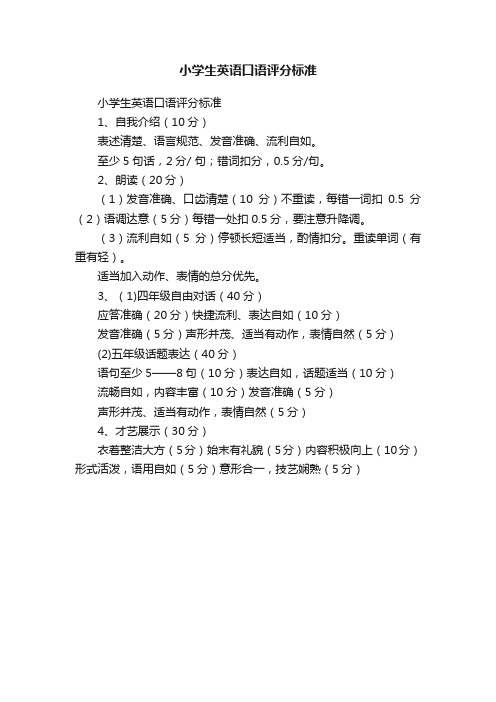
小学生英语口语评分标准
小学生英语口语评分标准
1、自我介绍(10分)
表述清楚、语言规范、发音准确、流利自如。
至少5句话,2分/ 句;错词扣分,0.5分/句。
2、朗读(20分)
(1)发音准确、口齿清楚(10分)不重读,每错一词扣0.5分(2)语调达意(5分)每错一处扣0.5分,要注意升降调。
(3)流利自如(5分)停顿长短适当,酌情扣分。
重读单词(有重有轻)。
适当加入动作、表情的总分优先。
3、(1)四年级自由对话(40分)
应答准确(20分)快捷流利、表达自如(10分)
发音准确(5分)声形并茂、适当有动作,表情自然(5分)
(2)五年级话题表达(40分)
语句至少5——8句(10分)表达自如,话题适当(10分)
流畅自如,内容丰富(10分)发音准确(5分)
声形并茂、适当有动作,表情自然(5分)
4、才艺展示(30分)
衣着整洁大方(5分)始末有礼貌(5分)内容积极向上(10分)形式活泼,语用自如(5分)意形合一,技艺娴熟(5分)。
英语口语评价量表
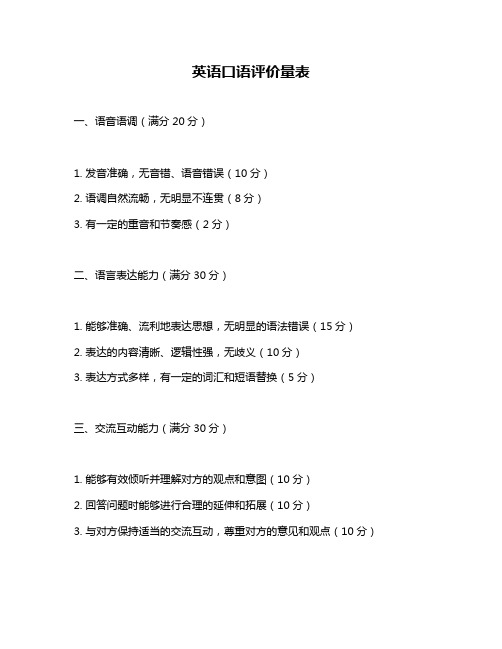
英语口语评价量表
一、语音语调(满分20分)
1. 发音准确,无音错、语音错误(10分)
2. 语调自然流畅,无明显不连贯(8分)
3. 有一定的重音和节奏感(2分)
二、语言表达能力(满分30分)
1. 能够准确、流利地表达思想,无明显的语法错误(15分)
2. 表达的内容清晰、逻辑性强,无歧义(10分)
3. 表达方式多样,有一定的词汇和短语替换(5分)
三、交流互动能力(满分30分)
1. 能够有效倾听并理解对方的观点和意图(10分)
2. 回答问题时能够进行合理的延伸和拓展(10分)
3. 与对方保持适当的交流互动,尊重对方的意见和观点(10分)
四、整体表现(满分20分)
1. 表达自信、流畅,无明显紧张或停顿(8分)
2. 对话题具有一定的热情和兴趣,积极参与讨论(6分)
3. 整体表现自然、得体,有一定的感染力和说服力(6分)。
英语口试考试评分标准

英语口试考试评分标准一、语音和发音(20分)在这一部分,考官将评估考生的语音和发音。
考生需要注意清晰、流利和准确地表达自己的意思。
1. 发音准确性(5分):考察考生是否能够正确地发音英语单词和短语。
2. 语音语调(5分):考察考生是否能够使用正确的语音语调,使得语言更具自然流畅的感觉。
3. 连音和重音(5分):考察考生是否能够正确运用连音和重音规则,从而使得句子更加地流畅自然。
4. 口语语速(5分):考察考生是否能够以适当的语速表达自己的意见,不过快或者过慢。
二、语法和词汇(30分)在这一部分,考官将评估考生的语法和词汇使用能力。
考生需要注意使用准确的语法结构和丰富的词汇,使得句子更加地清晰和准确。
1. 语法准确性(15分):考察考生对基本语法规则的熟练掌握程度,如时态、语态、从句等。
2. 词汇使用(15分):考察考生是否能够使用恰当且丰富的词汇表达自己的思想和观点。
三、语篇结构与逻辑(30分)在这一部分,考官将评估考生的语篇结构和逻辑思维能力。
考生需要注意句子之间的连贯性和段落之间的衔接性。
1. 句子连贯性(15分):考察考生是否能够正确地使用过渡词和连接词使得句子之间衔接自然。
2. 段落结构(15分):考察考生是否能够合理地组织句子和段落,使得文章结构紧凑完整。
四、语言运用(20分)在这一部分,考官将评估考生运用英语进行交流和表达的能力,包括对话能力、交际能力和语言运用的灵活性。
1. 对话能力(10分):考察考生是否能够积极参与对话,恰当地提出观点,并进行适当的回应和反驳。
2. 交际能力(5分):考察考生是否能够正确运用语言进行交际,包括问答、请求和道歉等。
3. 语言运用灵活性(5分):考察考生是否能够运用丰富多样的语言表达方式,使得交流更加地生动有趣。
五、语言理解(10分)在这一部分,考官将评估考生对听力和阅读材料的理解能力,包括对关键信息的捕捉和准确回答问题。
1. 听力理解(5分):考察考生是否能够听懂并正确回答听力材料中的问题。
英语口语考试评分标准

英语口语考试评分标准As an English language proficiency evaluator, I understand the importance of a standardized assessment to accurately measure a candidate's oral communication skills.In this document, we will delve into the criteria used to evaluate English speaking exams and provide detailed explanations for each category.Pronunciation:One of the key aspects of English speaking is pronunciation. It is crucial for candidates to articulate words and sounds clearly and accurately. Pronunciation is evaluated based on the candidate's ability to produce correct vowel and consonant sounds, stress and intonation patterns, and overall clarity of speech. A candidate with excellent pronunciation can be easily understood by native English speakers without any effort.Fluency:Fluency refers to the ability to speak English smoothly and effortlessly. It involves the candidate's speed of speech, the ability to link words and phrases, and the appropriate use of pauses. A fluent speaker can maintain a steady flow of speech, avoiding long pauses or hesitations. They can also express their thoughts and ideas without struggling to find the right words or phrases.Vocabulary:A wide-ranging vocabulary is essential for effective communication. Candidates are expected to use a diverse range of words and phrases, including idiomatic expressions and collocations. The use of appropriate vocabulary demonstrates the candidate's ability to convey their ideas accurately and precisely. It is also important for candidates to use vocabulary in context, showing an understanding of word meaning and usage.Grammar:Grammar plays a vital role in ensuring clarity and accuracy in spoken English. Candidates are evaluated on their ability to use correct grammatical structures, verbtenses, and sentence patterns. A candidate with strong grammar skills can construct grammatically correct sentences, avoiding common errors such as subject-verb agreement, verb tense consistency, and word order.Comprehension:Comprehension refers to the candidate's ability to understand and respond appropriately to questions or prompts. It includes listening comprehension, understanding the main idea, and responding effectively. Candidates should be able to comprehend both straightforward and complex questions, demonstrating their ability to grasp the meaning and provide relevant responses.Interactive Communication:Interactive communication evaluates the candidate's ability to engage in a conversation, initiate and respond appropriately, and maintain a meaningful exchange. It includes skills such as turn-taking, active listening, and asking for clarification. A candidate who excels in interactive communication can actively participate in a conversation, demonstrate good listening skills, and adapt their language to suit the context.Coherence and Cohesion:Coherence and cohesion refer to the overall organization and structure of the candidate's speech. It involves the logical progression of ideas, the use of appropriate linking words and phrases, and the ability to maintain a clear and coherent argument. A candidate with strong coherence and cohesion can present their ideas in a structured and organized manner, making it easy for the listener to follow their line of thought.In conclusion, the evaluation of English speaking exams encompasses various aspects such as pronunciation, fluency, vocabulary, grammar, comprehension, interactive communication, and coherence and cohesion. Each category plays a crucial role in determining a candidate's proficiency level. By understanding these evaluation criteria, candidates can focus on improving their weak areas and enhance their overall oral communication skills.。
英语专业四级口语评分标准

英语专业四级口语评分标准
英语专业四级口语评分标准通常按照以下五个方面进行评分:
1. Language Use(语言运用)
评分标准:主要考察语言的准确性、流畅度、词汇运用和语法结构的正确性等。
2. Vocabulary(词汇)
评分标准:测试考生词汇量的多少以及词汇运用是否得体、鲜明。
3. Pronunciation(发音)
评分标准:测试考生是否能够准确地读出英语音节,以及语音的自然度和流畅度。
4. Fluency(流畅度)
评分标准:测试考生是否能够以流畅自如的方式进行口语表达,以及掌握如何使用正确的语音、语调等。
5. Content(内容)
评分标准:测试考生所表述的内容是否主题明确、思路清晰、具有逻辑性和言之有据。
英语口语比赛评分标准

项 目 英 语 流 利 程 度 英 语 的 语 法 功 底 内 容 及 措 辞 4 整 体 形 象 1 分 数
评分等级
演讲连贯,十分流利。 基本连贯,无明显的停顿及失误。
3
整体流利程度不佳有明本无语法错误,但句子结构有较少不妥之处。
2
语法上有明显的错误。 文章结构合理,能恰当选择动词 形容词 且搭配及习惯用语无明显错误,有逻辑性。 文章结构较合理,措辞有明显的或不妥之处,但有一定的逻辑性。 结构松散,逻辑性不强。 与评委适当的目光交流。自信,感情自然充沛。适当的肢体语言。 规定时间内未完成演讲. 声音不够洪亮,清楚。
英语口语比赛的评定规则
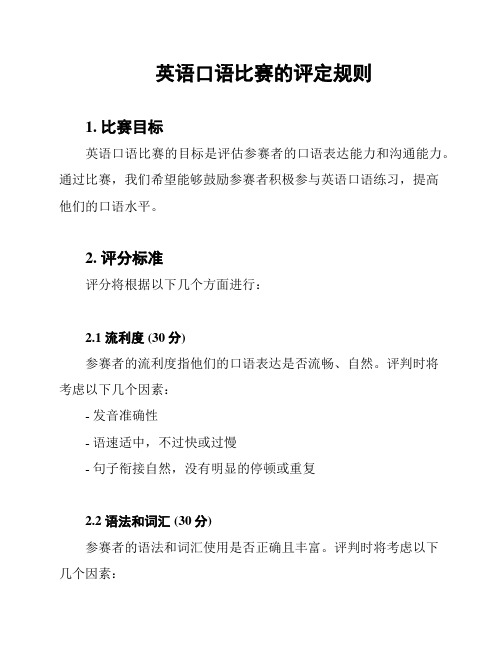
英语口语比赛的评定规则1. 比赛目标英语口语比赛的目标是评估参赛者的口语表达能力和沟通能力。
通过比赛,我们希望能够鼓励参赛者积极参与英语口语练习,提高他们的口语水平。
2. 评分标准评分将根据以下几个方面进行:2.1 流利度 (30分)参赛者的流利度指他们的口语表达是否流畅、自然。
评判时将考虑以下几个因素:- 发音准确性- 语速适中,不过快或过慢- 句子衔接自然,没有明显的停顿或重复2.2 语法和词汇 (30分)参赛者的语法和词汇使用是否正确且丰富。
评判时将考虑以下几个因素:- 句子结构的正确性- 词汇的准确性和多样性- 语法的灵活运用2.3 内容和逻辑 (20分)参赛者的内容是否准确、有逻辑性,能够清楚地表达自己的观点和想法。
评判时将考虑以下几个因素:- 是否理解题目要求并给出相关的回答- 是否有清晰的观点陈述和支持论据- 是否能够用恰当的例子和细节来支持观点2.4 发布表达 (20分)参赛者的表达方式是否自信、有感染力,能够引起观众的兴趣。
评判时将考虑以下几个因素:- 肢体语言和面部表情的运用- 声音的抑扬顿挫- 情感的表达和控制3. 评委责任评委将根据以上评分标准进行评分,确保公正、客观地评估每位参赛者的表现。
评委还应遵守以下几点:- 不受外界干扰,独立评判,不与其他评委讨论分数- 不偏袒任何一位参赛者,根据表现评分- 不透露评分结果,保密评分过程4. 答辩规则比赛中,参赛者需要回答评委提出的问题或进行主题演讲。
答辩规则如下:- 回答问题时,参赛者应尽量准确理解问题,并给出相关回答- 进行主题演讲时,参赛者应围绕主题展开,清晰表达自己的观点和想法- 答辩时间一般为3-5分钟,超时将扣分5. 总结以上是英语口语比赛的评定规则,通过这些评分标准和答辩规则,我们希望能够公平、客观地评估参赛者的口语能力,同时鼓励他们不断提高。
比赛结果将根据评委们的评分来决定,最终评分结果将是公正、准确的。
(完整版)英语口语测试评分标准
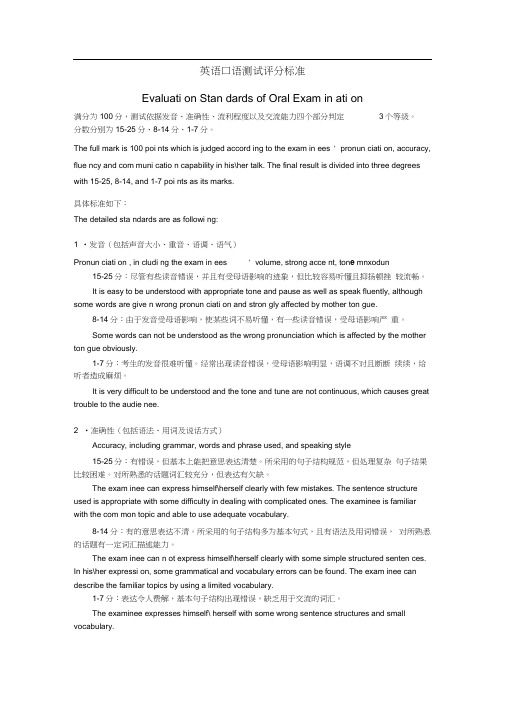
英语口语测试评分标准Evaluati on Stan dards of Oral Exam in ati on满分为100分,测试依据发音、准确性、流利程度以及交流能力四个部分判定3个等级。
分数分别为15-25分、8-14分、1-7分。
The full mark is 100 poi nts which is judged accord ing to the exam in ees ' pronun ciati on, accuracy, flue ncy and com muni catio n capability in his\her talk. The final result is divided into three degrees with 15-25, 8-14, and 1-7 poi nts as its marks.具体标准如下:The detailed sta ndards are as followi ng:1 •发音(包括声音大小、重音、语调、语气)Pronun ciati on , in cludi ng the exam in ees ' volume, strong acce nt, ton e mnxodun 15-25分:尽管有些读音错误,并且有受母语影响的迹象,但比较容易听懂且抑扬顿挫较流畅。
It is easy to be understood with appropriate tone and pause as well as speak fluently, although some words are give n wrong pronun ciati on and stron gly affected by mother ton gue.8-14分:由于发音受母语影响,使某些词不易听懂,有一些读音错误,受母语影响严重。
Some words can not be understood as the wrong pronunciation which is affected by the mother ton gue obviously.1-7分:考生的发音很难听懂。
英语口语口语考试评分标准

英语口语考试评分标准Part One: Reading Alound (5 points)
5分发音好,朗读十分流利
4分发音较好,朗读流利
3分发音尚可,朗读时偶尔出现停顿
2分发音较差,朗读时经常出现停顿
1分发音差,朗读时频繁出现停顿,无法完成朗读任务
1.口试考试形式:考官按照学号顺序测试考生,每位考生考试时间共三分钟。
先由考生抽签(抽签条由监考老师自己准备),朗读段落和话题均为6个,抽到哪个题号就考相应的朗读和话题。
2.口试步骤:Step 1:朗读段落(见试题1)。
Step2:考官根据话题提问1个材料中的问题(Topics见试题2)。
Step 3:考官根据考生的回答情况再即兴提问1个与本话题相关的问题。
3.口语考试总分15分,Reading Aloud分值5分,Answering questions分值为10分。
口试时请分开打分,口试表格中,试题1为朗读成绩,试题2为回答问题成绩,最后再把两小项的得分相加,得出总分。
请各位老师参照上面表格里的评分标准,尽量做到客观公正。
英语专业四级口语评分标准
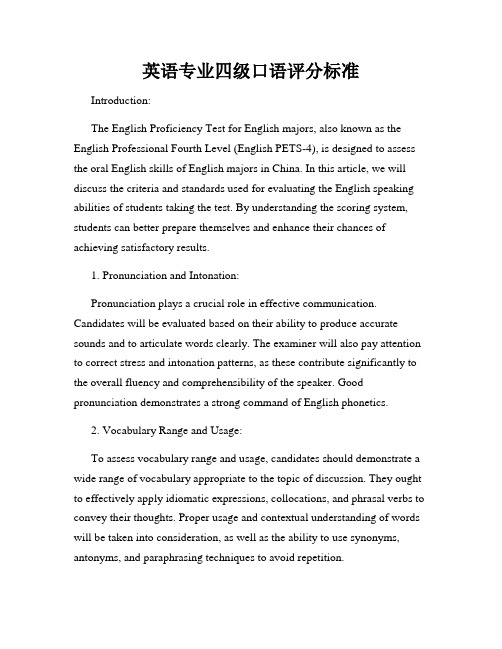
英语专业四级口语评分标准Introduction:The English Proficiency Test for English majors, also known as the English Professional Fourth Level (English PETS-4), is designed to assess the oral English skills of English majors in China. In this article, we will discuss the criteria and standards used for evaluating the English speaking abilities of students taking the test. By understanding the scoring system, students can better prepare themselves and enhance their chances of achieving satisfactory results.1. Pronunciation and Intonation:Pronunciation plays a crucial role in effective communication. Candidates will be evaluated based on their ability to produce accurate sounds and to articulate words clearly. The examiner will also pay attention to correct stress and intonation patterns, as these contribute significantly to the overall fluency and comprehensibility of the speaker. Good pronunciation demonstrates a strong command of English phonetics.2. Vocabulary Range and Usage:To assess vocabulary range and usage, candidates should demonstrate a wide range of vocabulary appropriate to the topic of discussion. They ought to effectively apply idiomatic expressions, collocations, and phrasal verbs to convey their thoughts. Proper usage and contextual understanding of words will be taken into consideration, as well as the ability to use synonyms, antonyms, and paraphrasing techniques to avoid repetition.3. Grammar and Sentence Structure:Grammatical accuracy is essential for clear and effective communication. Candidates will be evaluated on their ability to use different tenses, sentence structures, and complex grammatical patterns appropriately. They should demonstrate coherence in their speech by organizing ideas logically using connectors, conjunctions, and transitional phrases. Effective control of grammatical rules is essential for conveying meaning accurately.4. Fluency and Coherence:Fluency refers to the ability to express oneself smoothly and effortlessly without undue hesitation. Candidates should strive to maintain a natural pace, rhythm, and flow in their speech, while avoiding unnecessary pauses and disruptions. Coherence, on the other hand, refers to the logical arrangement and connection of ideas in a speech. Candidates must present their ideas in a cohesive manner, using appropriate discourse markers to link their thoughts together.5. Task Achievement:In order to demonstrate task achievement, candidates should address the given prompt effectively and provide relevant and coherent responses. They should express opinions, support arguments, and give examples appropriately within the given time frame. Clear and concise organization of ideas will be evaluated as the candidates articulate their thoughts and demonstrate critical thinking skills. A well-structured response with a clear introduction, body, and conclusion will be regarded favorably by examiners.6. Interactive Communication:The ability to engage in meaningful and dynamic interactions is an important aspect of oral communication. Candidates will be evaluated on their ability to ask and answer questions, engage in discussions, express agreement and disagreement, and negotiate meaning with the examiner or the partner in a paired activity. Listening and responding appropriately, as well as maintaining the flow of conversation, are key components of interactive communication.Conclusion:The English Proficiency Test for English majors assesses the oral English skills of candidates based on various criteria. By understanding and familiarizing themselves with the scoring standards, students can focus on improving their pronunciation, vocabulary, grammar, fluency, coherence, and interactive communication skills. Successful performance in these areas will contribute to a higher score on the English PETS-4, paving the way for future academic and professional success.。
常用英语口语「中英对照」

常用英语口语「中英对照」常用英语口语「中英对照」口语指日常口头交谈时使用的语言,所有的民族都有口语。
下面是店铺整理的一些英语口语,希望能帮到大家!What color is your book? 你的书本是什么颜色的?My book has a dark blue cover. 我的书本的封面是深蓝色的。
How much does that typewriter weigh? 那个打字机有多重?It’s not too heavy, but I don’t know the exact weight.它不是很重,但是我不知道它的精确重量。
This round table weighs about forty-five pounds.这张圆桌子重45磅。
What size suitcase do you own? 你的小提箱是什么尺码的?One of my suitcases is small, and the other one is medium size.其中一个提箱是小号的,另一个是中号的。
I like the shape of that table. 我喜欢那张桌子的形状。
How long is Jones Boulevard Street?Jones Boulevard街有多长?That street is only two miles long. 那条街只有两英里长。
Will you please measure this window to see how wide it is?你能量量这个窗户,来确定它有多宽吗This window is just as wide as that one.这个窗户仅仅和那个一样宽。
The walls are three inches thick. 这些墙有三英尺厚。
This material feels soft. 这种材料摸上去很软。
This pencil is longer than that one. 这个铅笔比另一个长。
- 1、下载文档前请自行甄别文档内容的完整性,平台不提供额外的编辑、内容补充、找答案等附加服务。
- 2、"仅部分预览"的文档,不可在线预览部分如存在完整性等问题,可反馈申请退款(可完整预览的文档不适用该条件!)。
- 3、如文档侵犯您的权益,请联系客服反馈,我们会尽快为您处理(人工客服工作时间:9:00-18:30)。
and occasional inability to adapt to new topics or changes of direction.
4
-Unintelligibility caused by grammatical/lexical errors.
-Frequent pauses while organizing thoughts and searching for words, which sometimes interfere with communication.
-Frequent contribution to the discussion but sometimes not to the point or without directly interacting with other participants.
-表达过程中词汇较丰富.
-发音尚可
-能进行较连贯的发言,但多数发言 较简短
-组织思想和搜寻词语时频繁出现停 顿,有时会影响交际
-能够较积极地参与讨论,但有时内 容不切题或未能与小组成员直接 交流
-语言的使用基本上能与语境、功能 和目的相适应
6
-语法和词汇有错误,且有时会影响交际
-表达过程中词汇不丰富,语法结构较简单
-Use of language basically appropriate to context, function and intention
6
-The use of grammatic al/lexic al items may be incorrect and sometimes impede communication.
-A basically satisfactory range of vocabulary to deal with the given task.
-Acceptable pronunciation.
-Manifestation of ability to produce coherent and more complex utterances, though most contributions are short.
-不能参与小组讨论
等级
等级描述
A+ (14.5- 15分)
A (13.5-14.4分)
能英语就熟悉的题材进行口头交际,基本上没有困难。
B+ (12.5-13.4分)
B(11 —12.4分)
能用英语就熟悉的题材进行口头交际,虽有些困难,但不影响交际。
C+ (9.5-10.9分)
C(8 —9.Βιβλιοθήκη 分)能用英语就熟悉的题材进行口头交际,虽有困难,但不影响交际。
which is difficult to follow, making communication almost impossible.
-Inability to take part in group discussion.
分档
语言准确性和范围
话语的长短和连贯性
语言灵活性和适切性
10
-语法和词汇基本正确
D (7.9分以下)
尚不具有英语口头交际能力。
-表达过程中词汇丰富、语法结构较为复杂
-发音较好,但允许有一些不影响理解的母语 口音
-在讨论有关话题时能进行较长时间 的、语言连贯的发言,但允许由于 无法找到合适的词语而造成的偶尔 停顿。
-能够自然、积极地参与讨论
-语言的使用总体上能与语境、功能 和目的相适应
8
-语法和词汇有一些错误,但未严重影响交际
-Fairly good pronunciation though some residual accent is acceptable.
-The ability to produce extended and fairly
coherent discourse concerning the given task, though with occasional pauses due to loss of words.
Score
Accuracy&Range
Size&Discourse Management
Flexibility&Appropriacy
10
-Basically correct use of grammatical and lexical items.
-Adequate vocabulary and a fair range of grammatical structures for the given task.
-Insufficient grammatical/lexical items to cope with the given task.
-Poor pronunciation that causes breakdowns in communication.
-Short utterances and disconnected speech,
-A minimum range of vocabulary and grammatical structures to cope with the given task.
-Pronunciation may be faulty and sometimes impede communication.
-Mainly short utterances.
-Long and frequent pauses while organizing thoughts and searching for words, which often interfere with communication, though basically fulfilling the given task.
-Natural and active participation in the discussion.
-Use of language generally appropriate to context, function and intention
8
-Errors in the use grammatical/lexical items that do not seriously interfere with communication are permissible.
-发音有缺陷,有时会影响父际
-发言简短
-组织思想和搜寻词语时频繁出现较 长时间的停顿,影响交际、但能够 基本完成交际任务
-不能积极参与讨论,有时无法适应 新话题或讨论内容的改变
4
-语法和词汇有较多错误,以致妨碍理解
-表达过程中因缺乏词汇和语法结构而影响交 际
-发音较差,以致交际时常中断
-发言简短且毫无连贯性,几乎无法 进行交际
